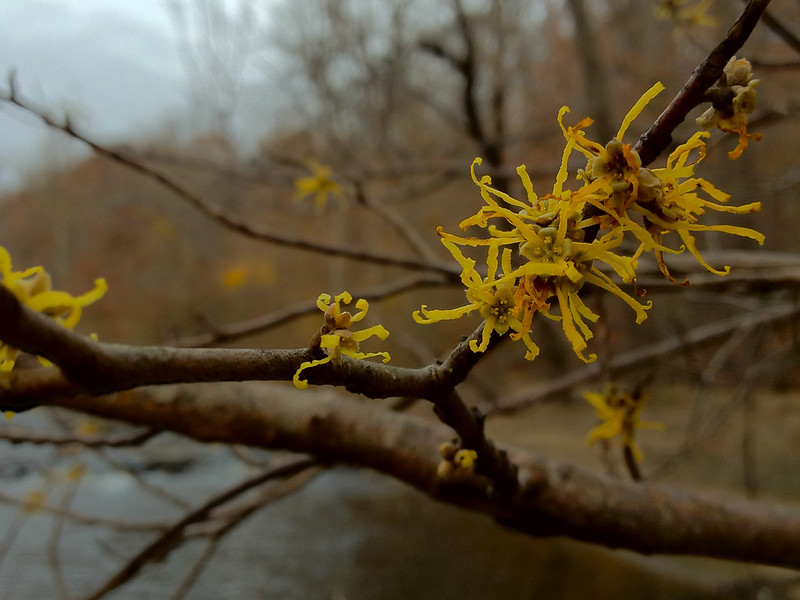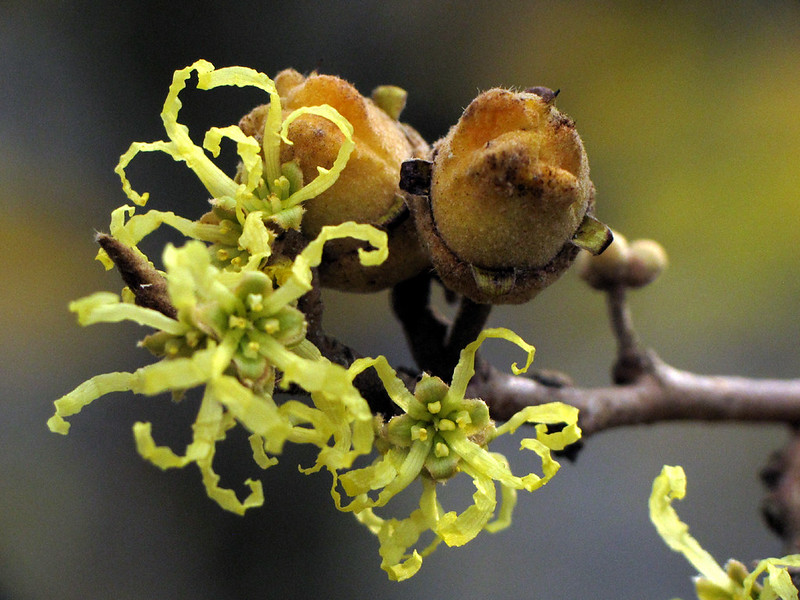Lurking beneath the dark forest canopy is the common witchhazel. With its gnarled, arching trunks and smooth, warty bark, this native understory species embodies the spirit of the Halloween season with its spooky features and mystic history.
It’s no surprise to learn that this Halloween-befitting shrub is a natural trickster, as it hides its identity behind the mask of many names. Some call it winterbloom, while others refer to it as spotted alder. In French, it is known as café du diable translating into the sinister-sounding Devil’s coffee. However, variations of the name witchhazel are the most commonly used.
What about that obvious mention of witches in the name, you ask? Well, it likely refers to the mystical powers of the shrub’s branches – but more on that later.
Despite all its naming tricks, the common witchhazel has only one scientific name: Hamamelis virginiana, which reveals its true identity. To fully appreciate this shrub’s eerie characteristics, we need to step deeper into the dark forest and take a closer look at its flowers and fruit.

By late autumn, most deciduous trees and shrubs have finished blooming and fruiting for the year and are in the final stages of dropping their leaves before winter. While the common witchhazel follows suit and sheds its leaves, it does something uniquely uncanny in the process: it flowers.
Incredibly, this shrub chooses the last moment of the year to bloom. This unique feature is reflected in its scientific name. Hamamelis comes from the Greek words hama (together with) and melon (apple), describing how this shrub flowers during the same time that apples ripen in autumn.
The sinuous ribbon-like yellow flowers are unmistakable, conjuring up images of spider legs and tentacles. But they don’t manage to scare away native pollinators who rely on this shrub’s blooms as an important late season food source.

Are you scared of what goes bump in the night? It just might be the common witchhazel making those mysterious noises after dark. After pollination, woody fruit capsules form and take a full year to ripen. By the time next year’s fall flowers are in bloom, the seeds inside the capsules are ready to emerge. With an audible snap, the seeds are ejected from the capsules, launching them into the air at around 20 miles per hour. This spellbinding phenomenon has even caught the attention of researchers. If the ghostly flowers and projectile seeds haven’t convinced you of this shrub’s chilling essence, its history certainly will.

The leaves, bark and branches of the common witchhazel have a long history of medicinal use. The shrub is often incorporated into topical medicines for muscle aches and for various skin conditions like burns, rashes, minor abrasions and insect bites. The use of this powerful plant continues today, but its supernatural reputation comes from another folkloric use.
Divination is the use of supernatural techniques to gain knowledge and includes practices like fortune-telling and crystal ball reading. Dowsing is a divination practice used to locate water, minerals and other desired items underground by using a forked twig called a dowsing rod. With the rod in hand, practitioners would walk and rely on its movement to reveal the exact location of buried goods. The common witchhazel was a preferred choice for these twig rods in North America, as they have naturally Y-shaped (forked) branches. The strong connection between the witchhazel twigs and this supernatural practice is one theory behind the shrub’s “witchy” name.

With its strange charms and mysterious past, the common witchhazel feels right at home during the spooky season.
Interested in planting one of these shrubs in your backyard this fall? LEAF has you covered! Common witchhazel can be purchased individually or as part of one of our discounted shrub bundles. Choose between the Native Bee Bundle or the Create Your Own Bundle and receive four native shrubs for the price of three, delivered right to your door! Bundles include mulch, a Planting and Care Guide and a specialized fact sheet for $100 +HST. Visit our Shrubs, Cedars and Pawpaws page to learn more and get started on your order today with our Shrub Request Form.
Jess Wilkin is an ISA Certified Arborist and the Residential Planting Programs Operations Supervisor at LEAF
LEAF offers a subsidized Backyard Tree Planting Program for private property. The program is supported by the City of Toronto, the Regional Municipality of York, the City of Markham, the Town of Newmarket, the City of Vaughan, the Regional Municipality of Durham, the Town of Ajax, the Municipality of Clarington, the City of Oshawa, the City of Pickering, the Township of Scugog, the Town of Whitby and Ontario Power Generation.
